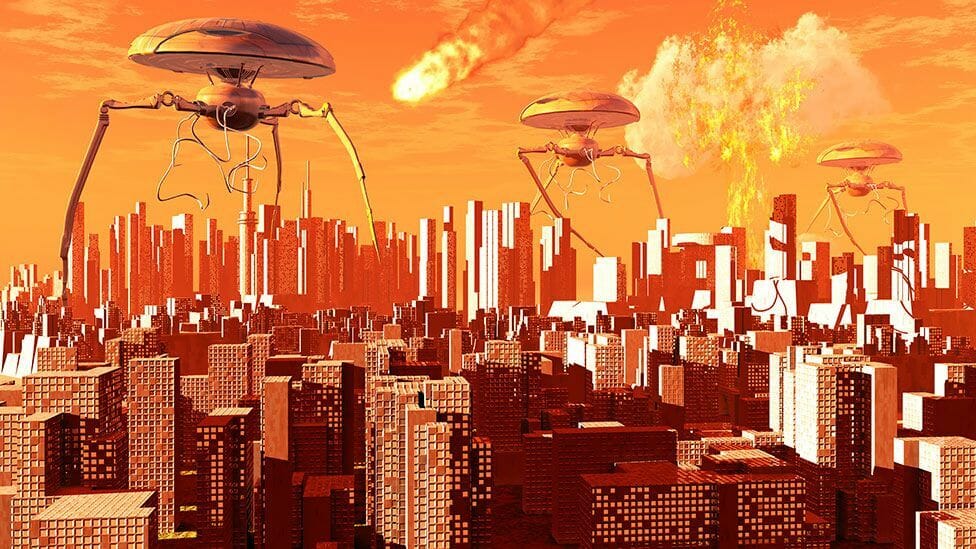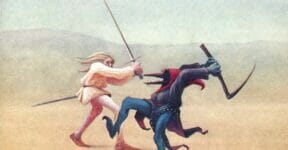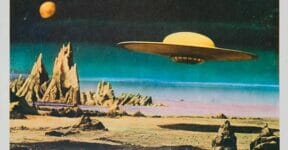The War of the Worlds, a sci-fi novel by H. G. Wells, was first published in hardcover in 1898. It told the story of an alien invasion through a rather simple premise that the planet Mars had reached a point of depletion, prompting the inhabitants to launch an attack in an attempt to take over planet Earth. Part of the plan was to wipe out the entire human population. Over the course of nearly 125 years, the novel has inspired more than a dozen War of the Worlds movies, video games, comic-book adaptations, television series, and various radio dramas. There have been also some sequels by other authors.
Initial Attack

In the novel, the Martians landed in England. News of the incident soon spread like wildfire thanks to an astronomer named Ogilvy who came to investigate the crash site. The locals – including story narrator – flocked around the impact crater; all expecting to see human-like extraterrestrial lifeforms emerge from a cylindrical spaceship. What they came across instead were monstrous robotic organisms. Using heat-ray weapons, they killed plenty of civilians in the vicinity. The narrator and a few others managed to flee the scene just in time.
1953 Adaptation Directed by Byron Haskin

In the 1953 film adaptation “The War of the Worlds,” directed by Byron Haskin, the aliens from Mars invaded Earth for the same reason as what the novel said. The Martians were at a dire circumstance because their home planet had reached a point of near total depletion. It could no longer sustain life, which made Earth a viable replacement.
Feed on Humans

H. G. Wells depicted the Martians as predators that preyed on humans. The aliens were not observed to be eating human flesh, but transfusing human blood into Martian bodies. There didn’t seem to be any sophisticated devices involved in the process except pipettes. Byron Haskin made no reference about the Martians using human bodies or organs in any way. However, there were speculations later that the invaders trained human slaves to track down survivors.
2005 Adaptation Directed by Stephen Spielberg

In Spielberg’s War of the Worlds, the aliens were depicted as coming from an unknown planet. It did not mention Mars as the invaders’ origin. It was a massive departure from the original premise, partly because a recent (at that time) NASA mission to Mars had revealed no sign of intelligent lifeforms. And it was said the aliens had been preparing for the invasion for millions of years; it might be a hint that the unknown planet was part of another solar system in the Milky Way galaxy.
Fighting Machine

The Martians used what were known in the novel as “Flying Machines” to reach Earth, and “Fighting Machines (or Tripod)” to launch the attack upon landing. In the 1953 film adaptation, the latter resembled the shape of manta rays with two types of weapons: a skeleton beam mounted on each wingtip and a heat ray on the top. As for the defense mechanism, the machine could emit magnetic energy shield strong enough to neutralize the impact of an atomic bomb attack.
In Spielberg’s version, the fighting machine was designed to look like the original Tripod. Instead of just three legs/tentacles, it featured a dozen or more of them and a dome-like head covered with two windshields. It also had two heat ray guns, capable of annihilating any organism but leaving inanimate objects intact. When the ray hit a person, the entire body would disintegrate, but their clothing was not affected at all.
Black Smoke

There was another weapon, called “Black Smoke” in the novel. The weapon looked like a bazooka that fired canisters filled with smoky powder. As the powder dispersed, any living organism that came into contact with it would die. Black Smoke was replaced with the skeleton beam in Haskin’s adaptation. The skeleton beam emitted bursts of green-colored pulses to break down the sub-atomic bonds of matter. Several French cities were obliterated using the weapon.
Ending in Both Films

In spite of all the differences in some details between the films and novels, they shared the same theme of a hostile encounter with extraterrestrial creatures. Furthermore, the endings were all the same in which the aliens finally lost the battle because their bodies had no defense against bacteria on Earth. The Martians might overwhelm humans and other complex organisms on the planet, but in reality their invasion had been doomed to fail from the beginning.
Radio Adaptation

While the two films introduced The War of the Worlds to larger audiences, the most famous adaptation was a radio play narrated by Orson Welles. It was broadcast on October 30, 1938 as part of his radio program, The Mercury Theatre on the Air, on CBS Radio network. According to the narrator himself, the play had been written and presented in a news-reporting style. As a result, some listeners – presumably those who were not familiar with the novel – mistook the fictional story as an actual news coverage.
One day after the broadcast, The New York Times reported that thousands of people in the United States and Canada relayed the information (that they thought was true) about Martian invasion to the police, radio stations, and newspapers. It was estimated that the radio play put nearly a million people to panic.
Popular Theme

H. G. Wells’ The War of the Worlds might not be the first novel to present the ideal of alien invasion, but it remains one of the most influential. Hostile extraterrestrial lifeforms have been a popular sci-fi theme in all major entertainment media including films, TV series, and especially video games. The graphic novel “The League of Extraordinary Gentlemen, Volume II” by Alan Moore retells the story in The War of the Worlds.
The War of the Worlds was written over 120 years ago at a time when mere flight was only being imagined. H. G. Wells certainly had one heck of an imagination to come up with the story, and his book remains one of the top science fiction classics of all time. Have you read The War of the Worlds or seen the movies? What do you think of the premise? Let us know. We’d love to hear from you.
If you liked this, then check out Top 26 Sci-Fi Fantasy Movies of the 1970s!
Other things you might want to know about.
What are some movies about viruses and pandemics?
- Outbreak (1995)
- Contagion (2011)
- World War Z (2013)
- 28 Days Later (2002)
- The Andromeda Strain (1971)
- Quarantine (2008)
- I Am Legend (2007)
- The Last Man on Earth (1964)
- 12 Monkeys (1995)
- Death in Venice (1971)
- Black Death (2010)
- The Masque of the Red Death (1964)
- Flu (2013)
- The Cassandra Crossing (1976)
- Infection (2019)
- The Happening (2008)
- Blindness (2008)
- Bird Box (2018)
- Carriers (2009)
- Zombieland (2009)
Got to parade.com to read details about each of these movies. The article is called ‘While We’re all Stuck at Home, Here are 20 Movies about viruses and pandemics you can stream right now’ by Kimberly Zapata.
The Best Zombie movies ever made
According to indiewire.com here are the greatest zombie movies ever made.
18. Zombieland (2009)
17. Dawn of the Dead (2004)
16. Little Monsters (2019)
15. ParaNorman (2012)
14. The Girl with All the Gifts (2016)
13. Night of the Living Dead (1968)
12. The Last Man on Earth (1964)
11. Ojuju (2014)
10. 28 Days Later (2002)
9. Cemetery Man (1994)
8. Train to Busan (2016)
7. Shaun of the Dead (2004)
6. Zombie (1979)
5. REC (2008)
4. Rabid (1977)
3. Re-Animator (1985)
2. I Walked with a Zombie (1943)
1. Dawn of the Dead (1978)
Go to indiewire.com to read more details about each of these movies. The article is called ‘The Best Zombie Movies Ever Made’ by Alison Foreman.
What are the best Infection/Zombie movies?
- Curse of the Undead (1959)
- Shivers (1975)
- Zombie Flesh Eaters (1979)
- The Return of the Living Dead (1985)
- Bone Sickness (2004)
- Shaun of the Dead (2004)
- Land of the Dead (2005)
- Swamp Zombies (2005)
- Mulberry Street (2006)
- Outpost (2007)
Go to all horror.com to find all the information about each of these movies. You can watch a trailer for each of the movies. Get your popcorn ready!






